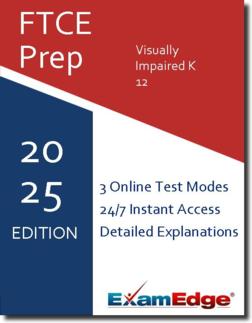FTCE Visually Impaired K-12 (044) Practice Tests & Test Prep by Exam Edge - Topics
Based on 22 Reviews
- Real Exam Simulation: Timed questions and matching content build comfort for your FTCE Visually Impaired K-12 test day.
- Instant, 24/7 Access: Web-based FTCE Visually Impaired K-12 practice exams with no software needed.
- Clear Explanations: Step-by-step answers and explanations for your FTCE exam to strengthen understanding.
- Boosted Confidence: Reduces anxiety and improves test-taking skills to ace your FTCE Visually Impaired K-12 (044).

Understanding the exact breakdown of the FTCE Visually Impaired K-12 test will help you know what to expect and how to most effectively prepare. The FTCE Visually Impaired K-12 has 100 multiple-choice questions The exam will be broken down into the sections below:
| FTCE Visually Impaired K-12 Exam Blueprint | ||
|---|---|---|
| Domain Name | % | Number of Questions |
| Subtest 1: Leadership for Student Learning | 25% | 11 |
| Knowledge of effective facilitation of positive achievement results aligned with student learning goals and state accountability measures | 25% | 11 |
| Knowledge of effective prioritization of student learning through leadership actions that build and support a learning organization focused on student success and continuous improvement | 25% | 11 |
| Knowledge of effective development and implementation of an instructional framework that aligns school curriculum with state standards, effective instructional strategies, student learning needs, and assessments | 25% | 11 |
| Knowledge of effective structuring and monitoring of a school environment that improves learning for all student populations | 25% | 11 |
| Subtest 2: Organizational Development | ||
| Knowledge of effective recruitment and induction practices to develop a high-performing, diverse faculty and staff | 17% | 8 |
| Knowledge of effective practices for the development and retention of high-performing, diverse faculty and staff | 33% | 15 |
| Knowledge of effective practices that cultivate, support, and develop leaders within the organization | 25% | 11 |
| Knowledge of personal and professional behavior consistent with quality practices in education and community leadership | 25% | 11 |


